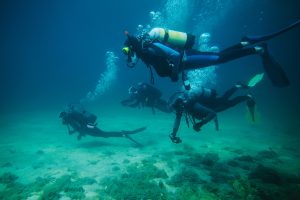 Have you ever been on an airplane, and felt uncomfortable because one of your ears “popped” and the other didn’t?
Have you ever been on an airplane, and felt uncomfortable because one of your ears “popped” and the other didn’t?
Chances are, you spent most of the flight swallowing or pinching your nose shut while exhaling.
If so, you already know the importance of what scuba divers call “equalizing” the ears.
As you become more involved in diving, however, you will want some safe techniques to equalize your ears. This will minimize both pain and the possibility of damaging your inner ears’ delicate structures.
Why Is It Necessary?
As you descend into the beautiful blue depths of the water, you will experience increasing amounts of pressure.
Equalizing your ears simply means increasing the pressure inside your middle ear to match the force of the external pressure.
If You Don’t Do It…
You’ll feel discomfort first, and then pain. With enough water pressure, the imbalance eventually becomes even greater. It may even rupture your eardrum or cause other damage.
What Exactly Takes Place When I Equalize?
There are small tubes that connect your middle ear to your mouth and throat.
These are called eustachian tubes, and they’re generally closed. This prevents bacteria and debris from entering the middle ear from the nasal cavity. To equalize the pressure between the water and your outer ear, you need to open the end of the eustachian tubes.
Using the Valsalva Maneuver
You’re probably already familiar with the Valsalva Maneuver.
It’s the technique we mentioned before, in which you pinch shut your nostrils and gently blow. It can be effective, but it’s best only for occasional use.
If this maneuver isn’t performed early enough before a dive (or often enough during), it can actually do more harm than good.
You see, the pressure differential itself can pinch shut the ends of the eustachian tubes. Forcing air against them using the Valsalva Maneuver can lock them shut. Plus, blowing too hard can actually rupture parts of the inner ear. Ouch!
Try These Instead
There are better, safer ways for scuba divers to equalize their ears. The safest methods that use the throat muscles to open the eustachian tubes, rather than air pressure.
Swallowing/Moving the Jaw
These motions come naturally when you’re trying to clear, or equalize, your ears.
Toynbee Maneuver
Pinch your nostrils shut and swallow. You’ll hear a gentle “pop” when your ear pressure is equalized.
Lowry Technique
This is a combination of the Valsalva and the Toynbee maneuvers. Blow and swallow at the same time, while holding your nostrils shut.
Voluntary Tubal Opening
Keeping the muscles of the throat tensed, push your jaw down and forward — as if you were yawning.
This technique takes some practice. It’s effective, though. In fact, some scuba divers develop such precise control over their throat and soft palate muscles that they can keep their eustachian tubes open continuously.
Ready to Dive?
Learning how to maintain equal pressure between the water and your middle ear is essential to a safe and enjoyable dive.
If you are a novice scuba diver, or simply want more instruction in this sport, give us a call!




